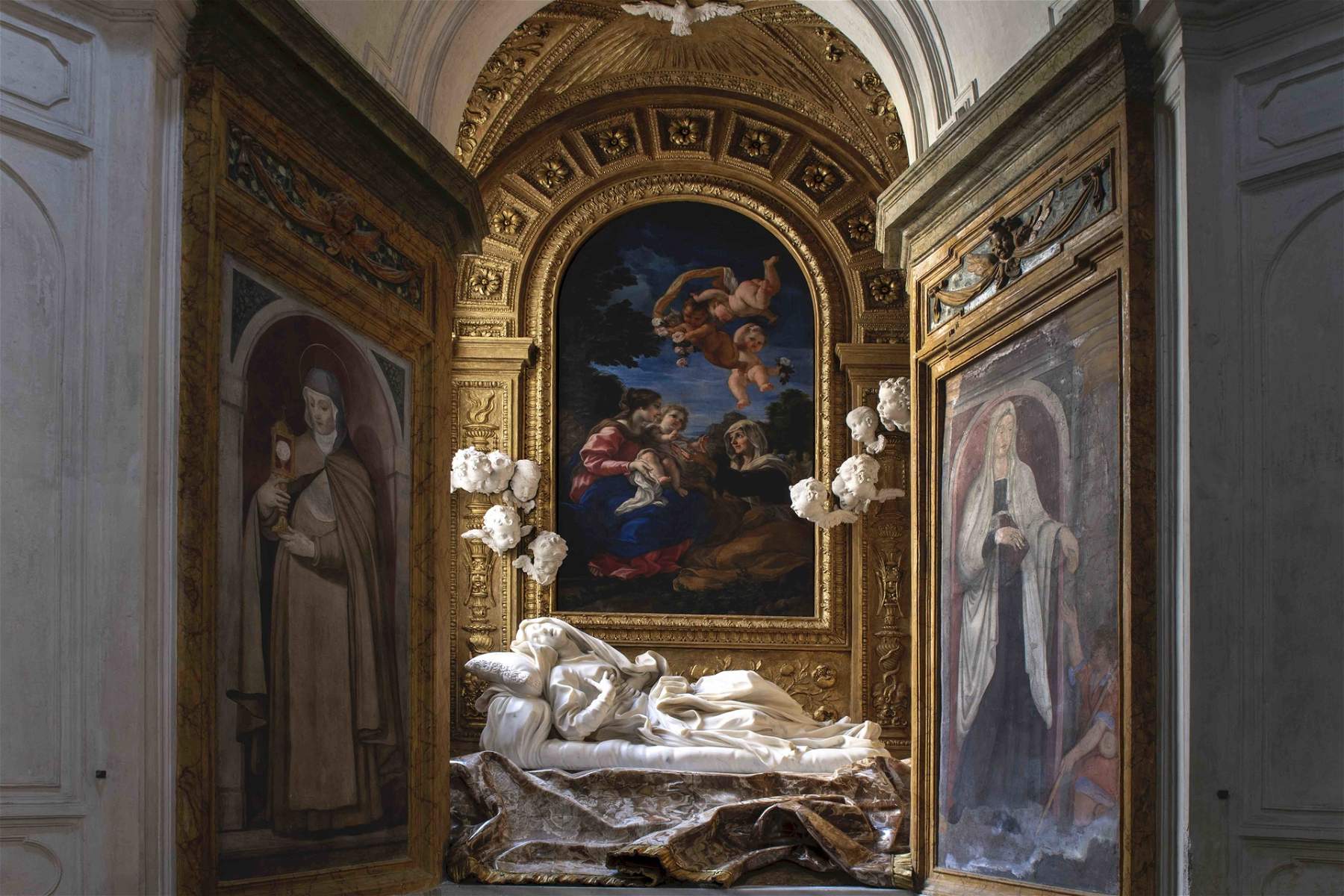The restoration of the Blessed Ludovica Albertoni Chapel in the Church of San Francesco a Ripa in Rome was completed in the past few hours. The site is famous because it houses the extraordinary marble sculpture of Blessed Ludovica Albertoni (Rome, 1473 or 1474 - 1533) created by Gian Lorenzo Bernini (Naples, 1598 - Rome, 1680) in 1674, in the extreme stages of his activity. Above, however, the chapel houses a canvas by Giovanni Battista Gaulli known as Baciccio (Genoa, 1639 - 1709), a Madonna and Child with St. Anne requested from the Genoese artist by Bernini himself, who intended thus to enhance the chapel’s studied scenographic effect, with the light coming from the two side windows and increasing the intensity of the ecstasy of the saint, observed by the ten cherubs flying above her.
The chapel had been commissioned to celebrate the nun Ludovica Albertoni, who had dedicated her life to the poor and needy, and was beatified in 1671: of noble origins, she had had three daughters and, despite her marriage, had become so close to Franciscan circles that, after the death of her husband, she decided to renounce her possessions and become a Franciscan tertiary, lending her services to those in need (she is remembered especially for her actions during the sack of Rome in 1527). When she was alive, Ludovica Albertoni used to attend the church of San Francesco a Ripa, and the chapel was commissioned from Bernini by a descendant of the blessed, Cardinal Angelo Paluzzi.
The restoration work lasted six months, was sponsored by the Special Superintendence of Rome, cost 39,000 euros and comes 20 years after the last restoration on the chapel. Restorer Elisabetta Zatti led the work: the intervention involved the statue of the blessed, but also the gilded scenery, the reliefs, the angels executed in white stucco, and the alabaster drape. The only work that was not touched was Gaulli’s canvas. The restoration first consisted of a cleaning operation on the statue (made from a single block of Carrara marble), which brought out the mode of Bernini’s work, which used different degrees of finish for the marble in order to create pictorial effects (almost as if it were a chiaroscuro in sculpture). In addition, the cleaning also affected the other elements of the decoration.
In fact, the work was blackened due to atmospheric particulate matter that had clouded the surfaces, and with the colors of the gold leaf decoration deteriorated by previous interventions. In essence, the work was not fully legible, and the intervention, in addition to ensuring better preservation of Bernini’s masterpiece, allowed it to be restored to greater legibility. Following the cleaning, consolidation and pictorial reintegration of the abrasions and alterations of the gold leaf were carried out, and then finished with watercolor glazes so as to restore the color balance of the chapel. For the cherubs, it was also necessary to protect the iron inserts used as supports, and a repair of gaps and cracks was also conducted.
“The restoration,” the special superintendent of Rome, Daniela Porro, told the Adn Kronos agency, “has highlighted Gian Lorenzo Bernini’s mode of operation. The great sculptor smoothed the most prominent parts of marble to the maximum and did not work the parts that were not visible. We worked not only for the protection and conservation of an extraordinary work, but also for its fruition and enhancement.” News also emerged about the context in which Bernini worked: "It seems that for this work, which originates from the St. Teresa of Avila in Santa Maria della Vittoria,“ Daniela Porro added, ”Bernini had not asked for any compensation. Apparently he wanted to ingratiate himself with the pontiff of the time, Clement X, in favor of his brother who was in exile. Once this monument was made, among other things in a very short time, the brother returned to Rome." Clement X’s brother, born Emilio Bonaventura Altieri, had been involved in a sex scandal, and a few months after the work was finished he returned to Rome.
The work of the superintendence, however, is not finished: now it will be the turn of a study aimed at recreating the correct lighting for the chapel (15 thousand euros have already been estimated for the intervention).
Pictured: the chapel after restoration. Ph. Credit Maurizio Necci
 |
| Rome, ends restoration of Chapel of Blessed Albertoni, masterpiece by Gian Lorenzo Bernini |
Warning: the translation into English of the original Italian article was created using automatic tools. We undertake to review all articles, but we do not guarantee the total absence of inaccuracies in the translation due to the program. You can find the original by clicking on the ITA button. If you find any mistake,please contact us.